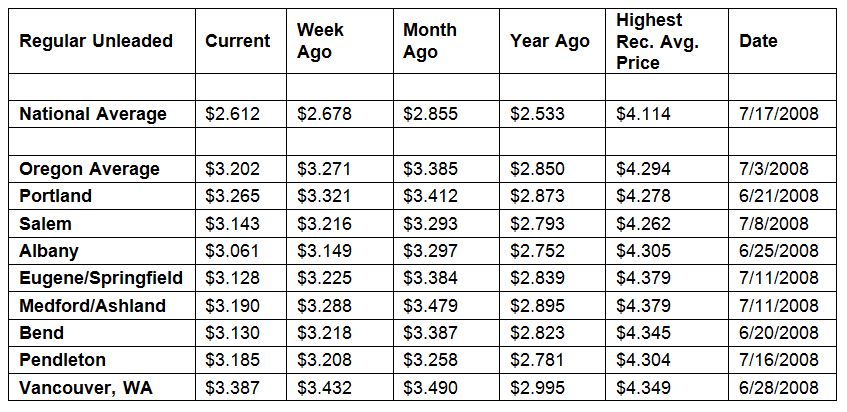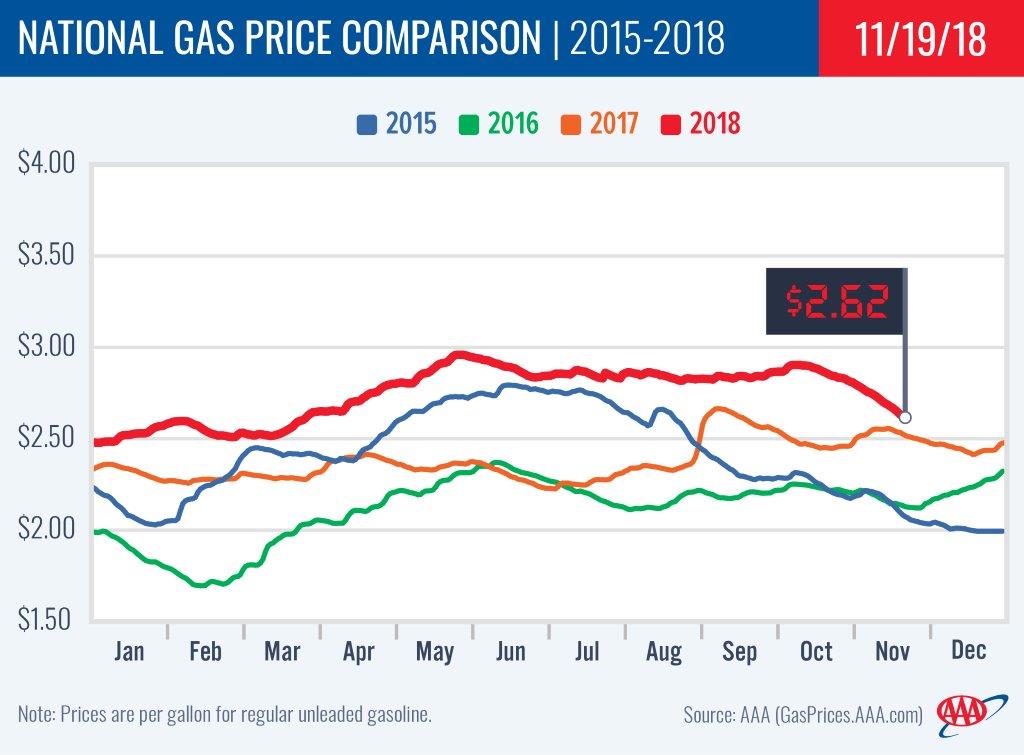Thanksgiving Travelers Thankful for Cheaper Gas Prices
PORTLAND, Ore., – Drivers can be thankful for the largest weekly drop of the year in pump prices as we head into the long Thanksgiving holiday weekend. Plunging crude oil prices and seasonably lower demand for gasoline are putting downward pressure on gas prices in all 50 states. For the week, the national average for regular loses seven cents to $2.61 while Oregon’s average also drops seven cents to $3.20. These are the largest one-week declines in pump prices this year.
AAA projects 54.3 million Americans will journey 50 miles or more away from home this Thanksgiving, a 4.8 percent increase over last year. About 704,000 Oregonians will head over the river and through the woods. This is the second-highest travel volume on record for the holiday, second only to 2005. The vast majority—89 percent—plan to go by car. In the Pacific Region, 86 percent plan a road trip. Roughly 609,000 Oregonians will drive. Find the complete AAA Thanksgiving travel news release here.
“When it comes time to fill up for your Thanksgiving road trip, keep in mind that gas stations along highly traveled routes may be more expensive. Download the free AAA Mobile app to find the lowest gas prices in your area,” says Marie Dodds, public affairs director for AAA Oregon/Idaho. “You can also find a list of what to include in your vehicle’s emergency kit. With snow expected in the mountain passes over the Thanksgiving weekend, you need to be prepared for winter driving conditions.” AAA.com/mobile.
Gas Prices are lower week-over-week in all 50 states and the District of Colombia. Iowa has the largest weekly decrease (-13 cents). Wyoming has the smallest weekly decrease (-2 cents). This week seven states have averages at or above $3 a gallon, same as a week ago.
Pump prices are lower than a month ago in every state and the District of Colombia. The national average is 24 cents less and the Oregon average is 18 cents less than a month ago. Iowa has the largest monthly decrease (-40 cents). Arizona has the smallest monthly decrease (-6 cents).
The West Coast continues to have the most expensive gas prices in the nation. Hawaii tops the list for the 24th week in a row with California, Washington, Alaska, Nevada, Oregon and Idaho rounding out the top seven. Oregon falls to sixth most expensive after four weeks at fifth.
On the week, Oregon and Hawaii have largest drops at seven cents each.
| Rank | Region | Price on 11/20/18 | |
| 1 | Hawaii | $3.82 | |
| 2 | California | $3.63 | |
| 3 | Washington | $3.40 | |
| 4 | Alaska | $3.30 | |
| 5 | Nevada | $3.21 | |
| 6 | Oregon | $3.20 | |
| 7 | Idaho | $3.01 | |
| 8 | Utah | $2.94 | |
| 9 | Wyoming | $2.89 | |
| 10 | Montana | $2.88 |
The U.S. Energy Information Administration’s (EIA) weekly petroleum status report for the week ending on November 9, showed West Coast gasoline stocks fell by 827,000 bbl to 26.5 million bbl. Stocks are approximately 1.7 million bbl lower than at this time last year, which could cause prices to spike if there is a supply challenge in the region this week.
The nation’s cheapest markets are Missouri ($2.26) and Delaware ($2.27) and. For the 68th week in a row, no states have an average below $2.
Drivers in 35 states and the District of Columbia are paying more than a year ago to fill up. The national average is eight cents more and the Oregon average is 35 cents more than a year ago. This is the eighth-largest yearly increase in the country. Hawaii (+58 cents) has the greatest year-over-year increase; Nevada (+48 cents) is second; Arizona (+46 cents) is third; Utah (+46 cents) is fourth; and California (+43 cents) is fifth.
Oil Market Dynamics
Crude oil prices have plunged to their lowest levels in a year. The latest EIA report shows crude inventories continue to build, now for the eighth consecutive week. Total domestic inventories sit at 442.1 million bbl, which is 16.9 million bbl lower than levels at this time last year. Inventories grew as the EIA reported the U.S. hit a new record for crude production last week. At 11.7 million b/d, it is the highest rate on record since the EIA began tracking it in 1983.
Growth in global crude production, including in the U.S., combined with weaker than expected global crude demand for the fourth quarter of 2018 are leading some market observers to have concerns that the global crude supply glut from 2016 and 2017 has returned. As a result, reports have emerged that the Organization of Petroleum Exporting Countries (OPEC), led by Saudi Arabia, will discuss curtailing crude production by 1 million to 1.4 million b/d at its upcoming meeting on December 6 in Vienna, Austria. Russia, which is not a member of OPEC, confirmed Monday that it would likely participate in any global crude production reduction agreement. Speculation of a production cut could help buoy crude prices this week. If an agreement is put into place in December, crude prices will likely rise due to reduced global supply.
At the close of Friday’s formal trading session on the NYMEX, WTI was unchanged and settled at $56.46. At the close of Monday’s formal trading session on the NYMEX, WTI added 30 cents to settle at $56.76. Today crude is trading around $54, compared to $57 a week ago. Crude prices are down about 22 percent in the last month and are about the same price per barrel than a year ago.
Drivers can find current gas prices along their route with the free AAA Mobile app for iPhone, iPad and Android. The app can also be used to map a route, find discounts, book a hotel and access AAA roadside assistance. Learn more at AAA.com/mobile.
Diesel
For the week, the national average falls three cents to $3.22 a gallon. Oregon’s average dips three cents to $3.40. A year ago the national average for diesel was $2.84 and the Oregon average was $3.02.
Find current fuel prices at GasPrices.AAA.com.
AAA news releases, high resolution images, broadcast-quality video, fact sheets and podcasts are available on the AAA NewsRoom at NewsRoom.AAA.com.



